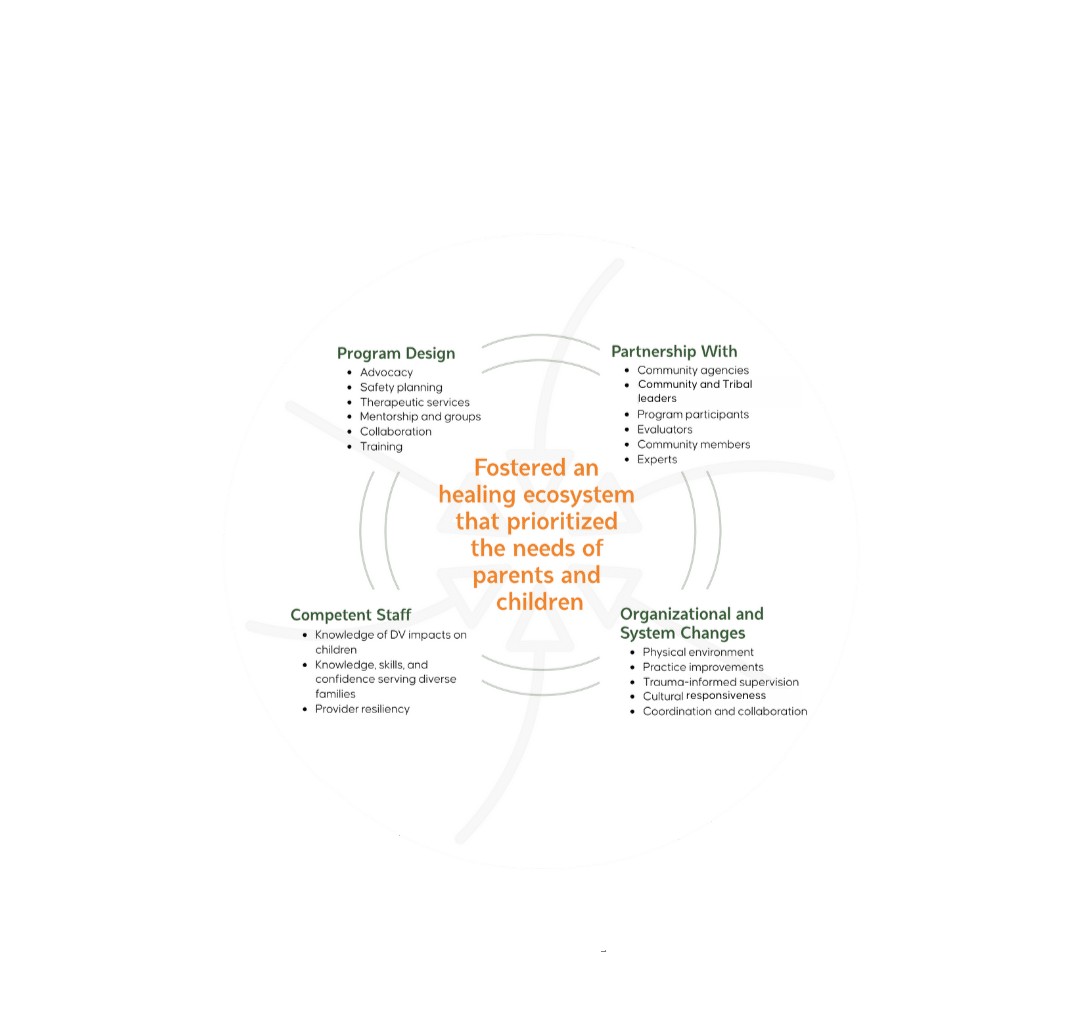What Happens When We Invest in Children Impacted by Domestic Violence?
Findings from the Inaugural Cohort of SSAPC Demonstration Grantees
Between 2016-2020, the Family Violence Prevention and Services program funded the Specialized Services to Abused Parents and their Children (SSAPC) grant program. The 12 funded projects piloted innovations to strengthen system responses, improve capabilities to serve domestic violence (DV) impacted children and youth, alleviate associated impacts among child and adult survivors, and deepen relationships between children/youth and parents.
Promising Futures, a project of Futures Without Violence was funded as the national capacity building center and was the primary technical assistance provider to the SSAPC grantees. Following the end of the first demonstration grant, Promising Futures undertook a systematic review and abbreviated outcome harvest of annual progress and evaluation reports with support from Strategic Prevention Solutions. The infographic below provides an overview, and examples, of the changes experienced by children and families and across the DV serving ecosystem that are attributable to grantees’ strategies, efforts, and actions throughout the grant period.
Grantees and their partners:
SAFE Alliance, TX
Foothill Family Service, CA
Cook Inlet Tribal Council, Inc., AK
Maine Behavioral Healthcare, ME
Domestic Violence Action Center, HI
Texas Council on Family Violence, TX
Boston Medical Center Corporation, MA
Mountain Comprehensive Care Center, KY
Southeast Alaska Regional Health Consortium, AK
Durham County Department of Social Services, NC
Idaho Coalition Against Sexual and Domestic Violence, ID
Kansas Coalition Against Sexual and Domestic Violence, KS
Centered parent and child survivors' healing by delivering services that were...
Evidence-Informed
Relevant to the unique needs
Developmentally Appropriate
Trauma-Informed
...and found programming successfully...
Enhanced relevance
Established collaborative, enduring partnerships across systems
Fostered supportive, trusting and warm relationships with families and providers
Improved availability and capacity for effective DV service delivery and trauma-informed practices
Increased safety and healing for parents and their children impacted by DV
Through practice innovation, grantees demonstrated measurable outcomes for child and parent relationships.
Due to the variety of strategies implemented by grantees, the following is proportionate evidence of this outcome.
Sustained and/or expanded reach, services, and information and referral to DV impacted families
Provided referrals and resources
Expanded the availability of DV specific mental health treatment services for families
Safety, support, advocacy, and guidance programming delivered to over 5,400+ children
Strengthened relationship quality between parents and their children
Youth reported increases in comfort talking to their parents
Increased parental self awareness of how DV impacted their family
Youth had greater social support and felt less blame for violence in their family
Youth more likely to get help when feeling scared
Youth reported benefits from mentorship relationships
Children were less likely to blame themselves for the violence
Parents gained knowledge and confidence with their parenting
Parents reported gains in knowledge about how to help their children heal
Parents reported increase in knowledge and skills related to positive parenting practices
Engaged in positive and protective parenting and DV supports
Parents felt better able to keep their families safer
Parents reported confidence in planning for their child’s safety
Increased number of providers conducting safety planning processes with parents and child survivors
Grantees Implemented Changes to their Response to Families Experiencing DV
Grantees and their community partners implemented policy, practice, and environmental changes to prioritize the safety of families. These changes resulted in better availability, assistance and increased safety.
Proportion of grantees documenting evidence of this outcome.
Fostered safe and supportive physical environments
Institutionalized Safe Rooms in court buildings
Updated common spaces to better meet families’ needs
Enhanced responsiveness of evidence-based approaches
Hired bilingual & bi-cultural providers increasing language availability for programming and training
Created materials and support groups that met the unique needs of families
Developed adaptations of evidence-based models
Organizational practice changes emphasized accountability for abusive partners and keeping families together, safely
Supported safe reunification and reduced foster care placement
Established and offered new programs for people who use violence
Trained child welfare staff to improve responses to DV
Strengthened Overall Community Ecosystem to Respond to Families Experiencing DV
Grantees worked with local agencies and experts to increase internal capacity and expand access to relevant programming. Intentional partnering across systems equipped professionals to better identify and respond to families.
Proportion of grantees documenting evidence of this outcome.
Strengthened relationships to increase availability of relevant DV programming
Expanded cross-sector learning collaboratives
Convened and trained community and state-wide leaders
Increased availability to services through new and improved referral systems
Expanded DV advocacy, staffing, and family-serving capacity
Implemented 24-hour text and chat lines
Trained providers in DV specific evidence-based therapeutic interventions
Utilized co-located DV advocates in non-traditional settings
Institutionalized child specific staffing positions and children’s programming
Improved provider wellness
1,000+ staff trained in trauma-informed responses
Increased trauma-informed supervision for staff working with families
Enhanced organizational strategies to address secondary trauma
Promoted safety & increased responsive services through effective CQI practices
Used feedback from families on availability, relevance, and gaps in services and made changes as needed
Hosted listening sessions with underserved communities
Increased the use of relationship-based universal education strategies instead of screening
Increased collaboration and provider skill in mitigating the impacts of DV on families
Child serving providers gained understanding, knowledge, and confidence
Increased knowledge of the effects of experiencing DV on children and strategies to support healing and resilience
We know that the SSAPC inaugural grantees improved services available to families impacted by DV through the use of…
















